China manufacturing: raising the stakes
15 December 2017
Euan Youdale met with the heads of Sany Palfinger, XCMG and LGMG, in China, to find out about their new access divisions and their global ambitions.
The competition in China is really heating up now that some of the big construction manufacturers in China have set up their own access divisions over the last 18 months. They include Sany Palfinger, XCMG and LGMG, all of which are interviewed in this feature.
Significant growth in China is happening despite the lack of specific regulations for the access setor; a situation set to remain unchanged in the near future.
One of the reasons for this, pertinent to the issue of safety, is the increasing litigiousness of Chinese society. The relatively new threat of being sued is having an effect in forcing a higher concentration on safety. Also, general regulations for worksites are developing; in the past an injury could cost the company involved around RMB 200000 ($30000) in fines, now accidents cost five to six times more.
There are other reasons too for the access sector’s rise, those being a reduction in the cost of production for scissor lifts, as they become more common and the components more readily available, along with the well-documented rise in labour costs.
Then, of course, there is the increasing influence of major global contractors, based outside China, that require their established onsite work practices to be copied when working in the country. On top of that the rental model is growing in line with the popularity of access equipment.
LGMG
These growth trends and advantages are not left unnoticed by the big construction manufacturers in China. Lingong Group Jinan Heavy Machinery (LGMG), for example, has been watching the sector with interest and feels it is the right time to move in. The company has already started widening its output beyond its core medium-sized construction equipment, in which it has always specialised, to offer both ends of the size spectrum. This includes access equipment, which the company has started producing on a large scale. And, true to form, LGMG is interested in starting a partnership with an established manufacturer in the access equipment sector.
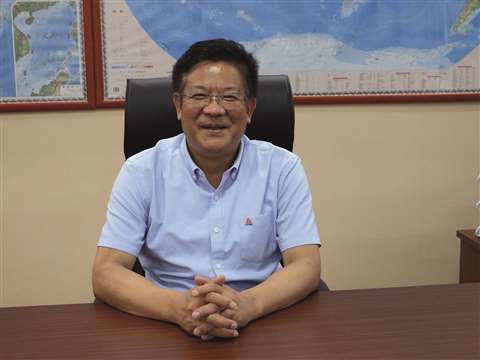
As Zhi Kaiyin, LGMG general manager explains, the industry has mainly concentrated on the mid-size construction products, like loaders and excavators but with the downturn in those products, larger and smaller machines have taken a greater proportion of sales. The company’s conscious decision to invest in those areas has seen it start two joint ventures, one with Sandvik, as part of its LGMRT mining and rock technologies segment, and the other with Volvo, representing the entire SDLG subsidiary. Under the two arrangements Sandvik owns 65%, while Volvo has 70% ownership of the respective ventures.
It is more than likely an equally well known company in the access sector will become the focus of a similar arrangement in the not too distant future, explains Zhi.
The company started producing loaders 45 years ago with the medium range 3 tonne and 5 tonne segment making up 80% of the business. In the large sector the company already has a 40 tonne truck and now has drilling rigs thanks to its partnership with Sandvik. Then, in the small segment, there are the 3.5 tonne to 15 tonne excavators and now MEWPs.
The plan is to offer the customer a full set of products. The manufacturer believes 27000 MEWPs were produced in China during 2016 across the eight biggest manufacturers producing in the country.
By the end of 2017, that volume will have reached 40000 with LGMG having produced produced 4% of that volume, says Zhi. LGMG’s target is to reach a minimum of 10% of the total output figure.
The company is already seeing an increase in both its domestic and export market, with China providing a 20% -30% increase in sales in the sector year-on-year. So far, the major focus for the company has been in the domestic market and, in an inspired move, it has been convincing its existing distributors to become rental companies.
“The China market is new for rental. We do not have this experience so we are learning how to teach rental companies to maintain productts and provide service,” explains Zhi.
LGMG believes it is a step ahead of the competition thanks to its cooperations with Volvo and Sandvik, which, in turn, have provided their experience in training and service, already establishing excavator and loader training for the Chinese market. “We understand the required levels of parts stock. We have learned from this and are ahead of the others,” says Zhi.
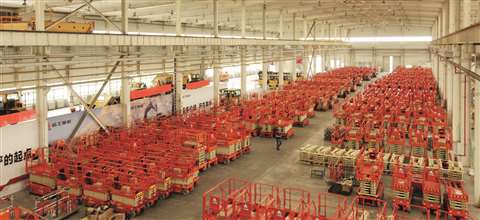
Beyond common international requirements for service and design, the Chinese market also has unique requirements that companies wishing so succeed must understand. One of those being that operators in China do not have the same 30 years of market and training experience behind them that ensure each new trainee will use the equipment properly. Indeed, the operators of MEWPs in China have often not come across them before and the equipment undergoes rougher use and needs to be designed accordingly. “So the premium design has to be modified for the Chinese market,” says Zhi.
The 4m to 14m electric scissors represent the core of the product line. There is also a three-year plan, which includes nine different product types, ranging from 3m-30m working height. Rough terrain scissors will follow soon, with a 16m unit in testing and 8m, 10m, 12m and 13m machines for the future.
Self propelled booms are also very much part of the equation, with 14m-30m booms. All these products are designed to cover 80%-90% of a typical rental company’s needs. “There is a full plan in place to sell and service these machines,” says Zhi.
As explained, with access being a particularly rental-related equipment type, LGMG is asking its distributor-base to become rental companies for the purpose of expanding the access market. So far 20 of the company’s 160 dealershave developed into AWP rental companies. On of them is Tongguan, a Volvo excavator and LGMG loader dealer, which has 1000 units in its fleet. Another example is Liaoning Shanzhong, also with 1000 units, having started last year in the rental business.
“The Chinese market is new for rental and must learn to use these machines and service them, plus the safety side. We do not have that experience in this country so we have to teach rental companies on site to maintain and service,” comfirms Zhi.
The company has also used its experience with its association with Volvo to create lean manufacturing at its plant. Before the end of the three years there will also be telehandlers in production, amounting to nine different product types.
Concerning the competition from major manufacturers of MEWPs that have set up in the country, Zhi says, “The premium brands in China are welcome as they help the market develop and understand the product. There will also be another benefit as more machines, particularly scissor lifts are produced in the country - the cost will come down.”
In 2015 the average cost if a 10m scissor was RMB 100000 ($15000), now a new unit should cost around RNB 80000 ($12000).
Adding to the company’s intentions to invest or partner in an access-related manufacturer, Zhi explains there is nothing specific in sight yet. “We are looking for one company for the global market. It is not easy to find the right one.”
Sany Palfinger
Another major company making headway into access is Sany Palfinger. Its Aerial Work Platform division, launched last year and has a different aim to its crane segment, which has been its mainstay so far, in that its products will be sold globally, hence the move to its current location in Rudong, close to the Shanghai, on the coast. The first factory was set up in Ningxiang, close to Changsha, due to its plans to sell the partnership’s crane products in China and Asia Pacific.
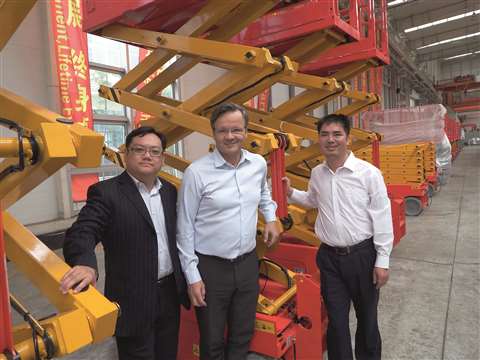
According to Johan Koenigshofer, chairman of the board of Sany Palfinger, the joint venture always intended to extend its offering from cranes to include aerial work platforms too, despite the product type being completely new for both companies.
The partnership represents an equal 50%/50% split between the two companies when it comes to investment in the brand. The joint venture also saw both companies taking a 10% stake in each other’s business.
All research and development takes place in China, using Austria-based Palfinger’s design expertise from its knuckle boom crane products to make models suitable for each market, for example including specific products for China. The joint venture’s initial focus is on perfecting its range of slab scissors. There are four models with 6m, 8m, 10m and 12m working heights, as well as a narrow version of the 8m model. Next up will be a 14m working height unit.
“There is an opportunity to get into the Chinese market, and we believe strongly that it has only just started. And we think that with high quality innovation it will be a very good market,” says Koenigshofer. Palfinger also has a full range of truck mounts thanks to its Palfinger Platforms operation in Germany for larger machines and Palfinger Platforms Italy for the lighter class vehicle mounts. This epertise has also been used in the creation of Sany Palfinger truck mounts.
“We want to provide a complete product line for lifting people,” adds Koenigshofer, who estimates the aerial work platform industry is growing 15% to 18% in China each year.
As mentioned, one element that will push that percentage growth up is more regulation. “There is no regulation yet defining lifting of people, although there are some talks. Regulation will change the market quickly.”
Sany Palfinger is in the process of finalising CE Marking certification of its scissor units for the wider market. The venture will also benefit from the existing distributor network in Southeast Asia and in Europe through parent company Palfinger. “We are not in North America yet but we are expecting the Sany organisation in North America will bring us to that market.”
While Palfinger is the biggest manufacturer of knuckle boom cranes in the world, with total annual revnue of Euro1.3 billion, including Palfinger Platforms, Koenigshofer believes the potential revenue for the company in the global AWP market is much greater. The plan is for the access to provide at least 50% of the revenue that Palfinger now generates on its own in the relatively near future.
Sany Palfinger is also offering a range of truck mounted platforms for China. “We will make changes for specific requirements in China, like a combined crane and platform,” explains Koenigshofer.
The reality is, however, the truck mount market in China is a very small one, with no major growth prospects in the near future. Therefore, in China the focus will be on scissor lifts.
Concerning the heavy competition in the scissor sector, Koenigshofer is not worried. “There are more than 100 manufacturers today but in five years’ time 40 of them will have gone.”
Tiger Peng, Sany Palfinger aerial work platform division managing director, believes product development is key for China, which is unique in its requirements. Peng says the development of software and control systems are vital to respond to the unique needs of operators in the country, who are often not used to these machines and therefore can use them roughly. “It is not easy to train operators in China we are developing software that will help them use the equipment.”
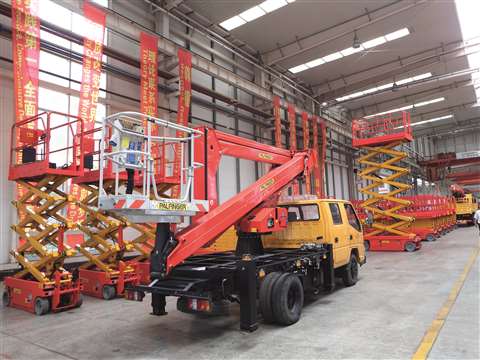
The Sany Intelligence unit is constantly investigating how to save energy and therefore costs in the product. This includes when the scissor stack is being raised and lowered. In short, the efficiency will be built into the structure of the units, with wider services like telematics, GPS and data transfer part of the design process. “The products will be different. People have different ideas now about what they need.”
Peng transferred to the access division from the excavator side of the business at Sany, and therefore has a good understanding of high volume products which the Sany Palfinger will be focusing on. “We are looking at products with a high population, so not big boom yet. Plus we will look at tailored products, like truck mounts that only a few customers need.”
The plan is to have one factory for the access division’s global needs. At the moment that factory has a capacity of 5000 units per year, although the land available at the Rudong location will allow it to double production.
As booms are added to the company’s product range, the view is they will account for some 15% of total volume at the factory – and the company says it will have completed a self propelled range in the next three years. On top of that, Sany and Palfinger has many existing facilities between them that could be adapted in the future to AWP production.
The company’s ambitions are reflected through its revenue expectations, with a current RMB300 million ($45 million) revenue that it wishes to double within the next five years. That will come from an initial focus on China, followed by Southeast Asia and then CE Marked countries.
Koenigshofer adds, “We will fight to take every chance that we have. The market is fragmenting and I think that 25% of products in Europe and North America will be represented by Chinese manufacturers. If customers can see better service from another company they will go to that company. “It is not just about residual value, you have to be able to sell the product.”
XCMG
Another very well-known generalist is XCMG, and it has some big ambitions too. Its general manager Li Qian Jin points to the company’s state-owned status as a major advantage, in that it is able to invest heavily in any sector it chooses, and there is no doubt access is seen as the next big thing in China.
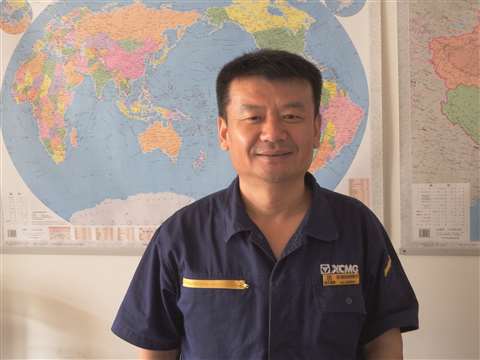
The new division Xuzhou Firefighting Safety Equipment is based in a former crane factory of the XCMG group in Xuzhou. Although this is not the first time the group has produced aerial work platforms. Back in 2008, it was producing telescopic booms with 22m, 28m and 32m working heights with luffing jibs, plus 38m and 40m units, using the manufacturer’s crane boom technology.
At the time the shipping industry was developing fast and self propelled booms were required, however it was a small division and beyond shipyards there were no requirements for access equipment. Cranes, on the other hand, were booming, so it was natural they were the dominant production item. It was not until 2012 that access equipment started showing signs of being a serious contender, and so it was around 2014-2015 that XCMG started to turn its attention again to access.
Incidentally, at that time XCMG had a truck mounted loader crane division which also started producing scissors. It meant there were two divisions in the group that were effectively competing against each other. It was decided the truck division would concentrate on truck mounted platforms, while Xuzhou Firefighting Safety Equipment would solely produce a complete range of self propelled models.
“We have a long term strategy but we have to start with the products that are most popular and most in demand,” says Li, “We want to produce safe, reliable, efficient and environmentally-friendly machines. Everything we do now is based around these factors.”
The hope is to become an international brand on the same scale as the top two manufacturers JLG and Genie, says Li. “The long term vision is to become the market leader, although we realise that is a long way off. We hope that when people talk about the access industry they will talk about XCMG.” This includes plans for growth in Europe.
In China, XCMG’s own rental company subsidiary Guanglian, started in 2011, will help, and, at the moment, most sales of access equipment goes to this rental concern. The advantage is that end users get the opportunity to test the XCMG product in the field.
Although the percentage is reducing, last year Guanglian took 95% of XCMG’s access equipment. This year it is set to be 70%, with the remaining 30% going to rental customers, mainly in China.
Those percentages amount to 1000 units last year and 2000 units this year, with a production capacity of 600 units a month – bearing in mind XCMG’s extensive facilities and buying power this could increase by as little or as much as is required.
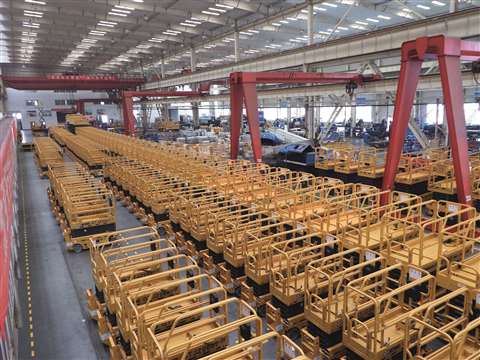
China has been divided into six territories for access, each with its own manager focusing on sales, as well as after sales service and parts. Li believes the strong support and cash flow XCMG has from the state will be to its advantage, along with the strong team that has worked for the company for many years. As far as export sales are concerned the company relies on its XCMG Overseas subsidiary.
Although Li is of the view that XCMG needs to build sales in China before making major inroads abroad, there is still a move to identify overseas potential from the start. The access division has five employees seeking clients outside of China that work alongside XCMG Overseas. At the moment it covers Southeast Asia and northern Asia, including Thailand, Korea and, as an aside, a big order from Turkey and another order from Algeria.
Export currently stands at about 15%, although the wish is to increase that significantly, with ultimately a move into North America, which for most Chinese manufacturers is the biggest challenge of all. “I would not say it is impossible but as a newcomer you are the snake – it is not that easy for the snake to swallow the elephant,” explains Li. “XCMG access is at an early stage.”
Would XCMG consider acquiring an existing company somewhere in the overseas market? The answer, says Li, is yes. And, as a state-owned company XCMG may be in a better position to do that than others. However, the time has to be right and at the moment XCMG is concentrating on developing its own brand and becoming respected and well known in the global market.
